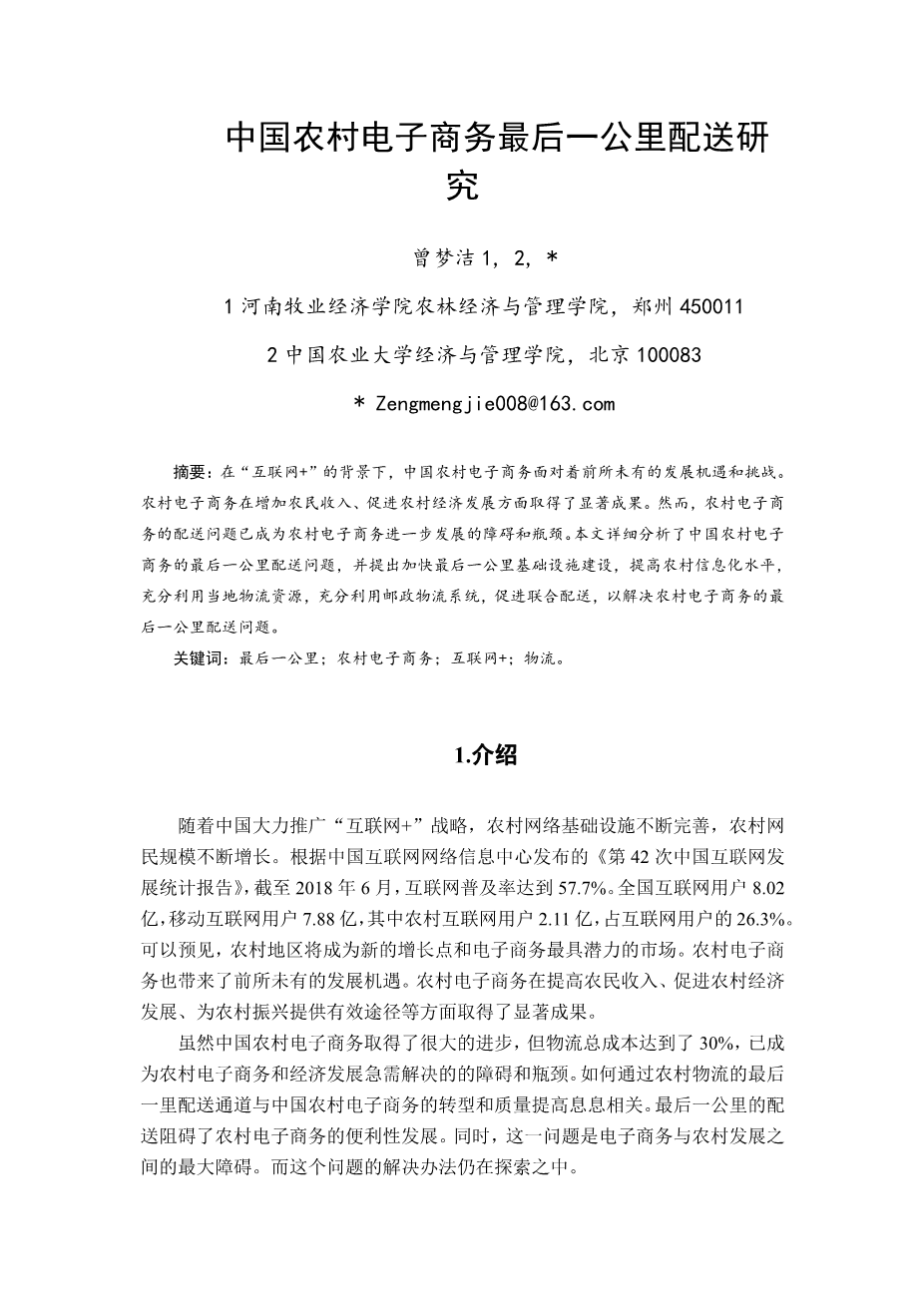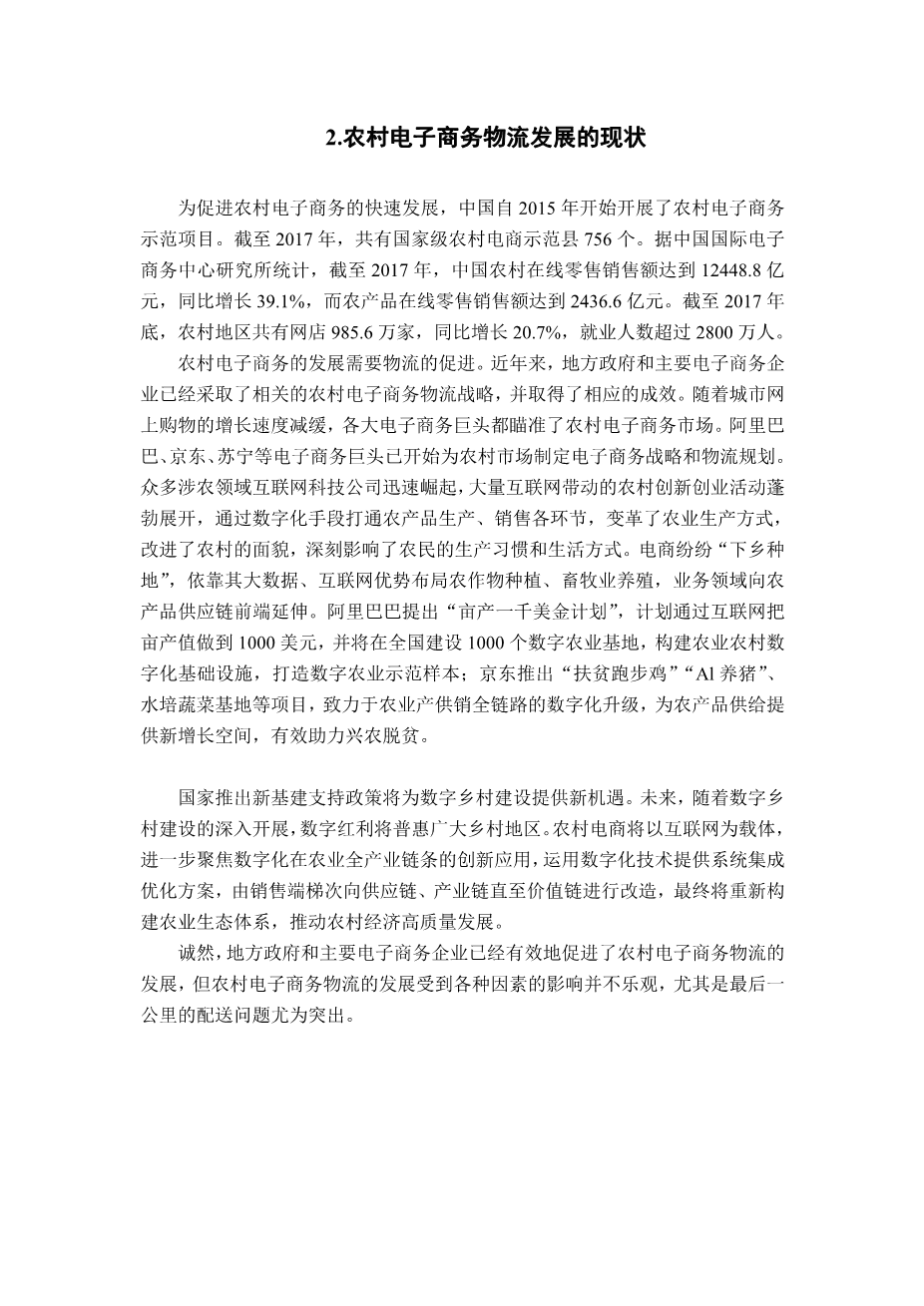Research on the Last Mile Delivery of Rural E-commerce in China
Mengjie Zeng 1, 2, *
1 College of Agro-Forestry Economics and Management, Henan University of Animal Husbandry and Economy, Zhengzhou 450011, China;
2 College of Economics and Management, China Agricultural University, Beijing 100083, China.
Abstract. Under the background of 'Internet Plus', Chinas rural e-commerce has ushered in unprecedented development opportunities and challenges. Rural e-commerce has achieved remarkable results in increasing farmers income and promoting rural economic development. However, the last mile delivery problem of rural e-commerce has become an obstacle and bottleneck for the further development of rural e-commerce. This paper analyzes in detail the last mile delivery problems of rural e-commerce in China, and then proposes to quicken the last mile infrastructure construction, improve rural informatization level, make the most of local logistics resources, make full use of Postal logistics system, and promote joint distribution, in order to solve the last mile delivery problems of rural e-commerce.
Keywords: Last Mile; Rural e-commerce; Internet Plus; Logistics.
1.Introduction
With Chinas vigorous promotion of the 'Internet Plus ' strategy, rural network infrastructure has been continuously improved, and the scale of rural netizens has continued to grow. According to the '42nd Statistical Report on Internet Development in China' released by China Internet Network Information Center, as of June 2018, the Internet penetration rate reaches 57.7%. There are 802 million total Internet users and 788 million mobile Internet users, among which the number of rural Internet users is 211 million, accounting for 26.3%. It is foreseeable that rural areas would become new growth points and the most potential market for e-commerce . Rural e-commerce also ushers in an unprecedented development opportunity. Rural e-commerce has achieved remarkable results in increasing farmers income, promoting rural economic development, and providing an effective path for rural revitalization.
Although Chinas rural e-commerce has made great progress, the last mile delivery, which accounts for 30% of the total logistics cost, has become an obstacle and bottleneck of rural e- commerce and economic development, and needs to be solved urgently. How to get through the last mile delivery channel of rural logistics is related to the transformation and quality improvement of Chinas rural e-commerce. As the last mile delivery is not smooth, the convenience of rural e- commerce is difficult to highlight. This problem is the biggest obstacle between e-commerce and rural development. The solution of this problem is still under exploration.
2.The Current Situation of Rural E-commerce Logistics Development
In order to promote the rapid development of e-commerce in rural areas, China has carried out the demonstration project of e-commerce in rural areas since 2015. By 2017, there are 756 national-level rural e-commerce demonstration counties. According to statistics from the China International E-commerce Center Research Institute, by 2017, Chinas rural online retail sales reached 1244.88 billion yuan, up 39.1% year-on-year, while the online retail sales of agricultural products reached 243.66 billion yuan. By the end of 2017, there were 9,856,000 online shops in rural areas, up 20.7% year-on-year, and more than 28 million people were employed.
The development of rural e-commerce needs logistics. In recent years, local government and major e-commerce enterprises have adopted relevant strategies for rural e-commerce logistics, and achieved certain results. With the slow growth of urban online shopping, various e-commerce giants have targeted at rural e-commerce market. Many Internet technology companies in agriculture related fields are rising rapidly, and a large number of rural innovation and entrepreneurship activities driven by the Internet are booming. Through digital means, we have opened up all links of agricultural product production and sales, changed the mode of agricultural production, improved the appearance of rural areas, and deeply affected the production habits and lifestyle of farmers. Relying on the advantages of the Internet, the front-end distribution of crop farming and e-commerce has been extended to the field of farming and animal husbandry. Alibaba put forward the '1000 US dollars per mu plan', which plans to achieve 1000 US dollars per mu output value through the Internet, and will build 1000 digital agriculture bases across the country, build agricultural and rural digital infrastructure, and create digital agriculture demonstration samples; Jingdong launched projects such as 'poverty alleviation running chicken', 'Al pig raising' and hydroponic vegetable base, committed to the digital upgrading of the whole link of agricultural production, supply and marketing, provided new growth space for the supply of agricultural products, and effectively helped revitalize agriculture and get rid of poverty.
The introduction of new infrastructure support policies by the state will provide new opportunities for the construction of digital countryside. In the future, with the in-depth development of digital village construction, digital dividends will benefit the vast rural areas. Rural e-commerce will take the Internet as the carrier, further focus on the innovative application of digitization in the whole agricultural industry chain, use digital technology to provide system integration optimization scheme, and transform from the sales end echelon to the supply chain, industrial chain and value chain. Finally, it will rebuild the agricultural ecosystem and promote the high-quality developmen
剩余内容已隐藏,支付完成后下载完整资料


英语译文共 7 页,剩余内容已隐藏,支付完成后下载完整资料
资料编号:[589612],资料为PDF文档或Word文档,PDF文档可免费转换为Word
课题毕业论文、文献综述、任务书、外文翻译、程序设计、图纸设计等资料可联系客服协助查找。


